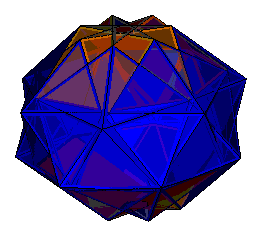
Gyro-elongated Spheno-prisms
A further family is that of Gyro-elongated Spheno-Prisms. The 7/3 Gyro-elongated Spheno-prism is shown above. The square cingulum in the Elongated Spheno-Prism is replaced here by a cingulum of 6n triangles, which wraps around the prismatic symmetry axis d times. The base n/d-gon is still surrounded by (type A) vertices of the form n/d.4.3.3.4 Type (B) vertices are now of the form 3.3.3.3.3 and type (C) vertices of the form 4.3.3.3.3. The cingulum introduces some distortion to the Spheno-prism cap and the type (B) vertices are now pulled nearer to the solid's equator than the Type (C) vertices. The convexity of this family is clearly seen in this 7/3 Gyro-elongated Spheno-prism with only one loop of the cingulum around the prismatic symmetry axis.
As a result of the distortion the term 'Gyro-elongated Spheno-Prism' is not technically correct, alternatives would be either Pseudo-Gyro-elongated Spheno-Prism or following on from the families only truly convex member (see below) the term Spheno-cingulum. Having given that health warning, I will however use the term Gyro-elongated Spheno-Prism in this page and its linked models.
The lower limit for convexity is still n/d=2, this is a 'Gyro-elongated Disphenoid' or to give it its formal name as a Johnson Solid, a disphenocingulum, this is the only n-gonal convex member of this family. However, due to the distortion mentioned above the upper limit is now somewhat less than n/d=3. This is apparent from this model of the Triangular Gyro-elongated Spheno-Prism (with n/d=3) The type (B) vertices clearly show an element of concavity as there is a definite valley between the two triangles connected to the prismatic face. The upper limit for convexity is between 2.8 and 3 as can be seen from this 14/5 Gyro-elongated Spheno-prism or this example with only one loop of the cingulum around the prismatic symmetry axis.
The distortion of the Spheno-prismatic caps means that in many examples the type (C) vertices are not internal. From the models generated with n<=12, if d=2,4 or 5 then the type (C) vertices are visible in a solid model, but not if d=3. I do not know if this remains the case for n>12.
A full list of locally convex Gyro-elongated Spheno-prisms with d>1 and n<=12 is below. The "Cutaway" models have one sphenoidal cap removed. These are possibly the most effective models at revealing the structure of the cingulum.
| 5/2
Cutaway |
7/3
Cutaway |
8/3
Cutaway |
9/4
Cutaway |
11/4
Cutaway |
11/5
Cutaway |
12/5
Cutaway |